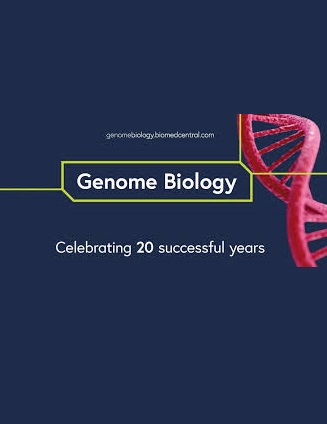对 SETD2、NSD1、NSD2、NSD3 和 ASH1L 的系统扰动揭示了它们对 H3K36 甲基化的不同贡献
IF 10.1
1区 生物学
Q1 BIOTECHNOLOGY & APPLIED MICROBIOLOGY
引用次数: 0
摘要
组蛋白 3 赖氨酸 36(H3K36me)的甲基化已成为忠实调控基因表达的重要表观遗传成分。尽管组蛋白3赖氨酸36(H3K36me)在发育和疾病中具有重要作用,但分子介质如何共同塑造H3K36me景观尚不清楚。我们利用小鼠间充质干细胞扰乱H3K36me甲基转移酶(K36MTs),并推断出五种最主要酶的活性:SETD2、NSD1、NSD2、NSD3和ASH1L。我们发现,H3K36me2 是三种甲基化状态中最丰富的一种,主要由 NSD1 沉积在基因间区域,部分由 NSD2 沉积。相比之下,H3K36me1/3 在外显子中含量最高,并且与基因表达呈正相关。我们证明,虽然 SETD2 沉积了大部分 H3K36me3,但它也可能在转录基因内沉积 H3K36me2。此外,SETD2 的缺失会导致外显子 H3K36me1 的增加,这表明其他(K36MTs)会在转录前以较低的甲基化状态为基因体提供营养。NSD1/2 建立了广泛的基因间 H3K36me2 域,而 NSD3 则将 H3K36me2 峰沉积在活跃的启动子和增强子上。同时,ASH1L 的活性仅限于发育相关基因的调控元件,我们的分析还发现 PBX2 是一个潜在的招募因子。在基因内,SETD2 主要沉积 H3K36me3,而其他 K36MTs 则独立于 SETD2 的活性沉积 H3K36me1/2。在 H3K36me1/2 的沉积方面,我们发现 K36MT 的活性存在一个层次结构,即 NSD1 > NSD2 > NSD3 > ASH1L。NSD1 和 NSD2 负责 H3K36me2 在整个基因组范围内的大部分传播,而 NSD3 和 ASH1L 的活动则局限于活跃的调控元件。本文章由计算机程序翻译,如有差异,请以英文原文为准。
Systematic perturbations of SETD2, NSD1, NSD2, NSD3, and ASH1L reveal their distinct contributions to H3K36 methylation
Methylation of histone 3 lysine 36 (H3K36me) has emerged as an essential epigenetic component for the faithful regulation of gene expression. Despite its importance in development and disease, how the molecular agents collectively shape the H3K36me landscape is unclear. We use mouse mesenchymal stem cells to perturb the H3K36me methyltransferases (K36MTs) and infer the activities of the five most prominent enzymes: SETD2, NSD1, NSD2, NSD3, and ASH1L. We find that H3K36me2 is the most abundant of the three methylation states and is predominantly deposited at intergenic regions by NSD1, and partly by NSD2. In contrast, H3K36me1/3 are most abundant within exons and are positively correlated with gene expression. We demonstrate that while SETD2 deposits most H3K36me3, it may also deposit H3K36me2 within transcribed genes. Additionally, loss of SETD2 results in an increase of exonic H3K36me1, suggesting other (K36MTs) prime gene bodies with lower methylation states ahead of transcription. While NSD1/2 establish broad intergenic H3K36me2 domains, NSD3 deposits H3K36me2 peaks on active promoters and enhancers. Meanwhile, the activity of ASH1L is restricted to the regulatory elements of developmentally relevant genes, and our analyses implicate PBX2 as a potential recruitment factor. Within genes, SETD2 primarily deposits H3K36me3, while the other K36MTs deposit H3K36me1/2 independently of SETD2 activity. For the deposition of H3K36me1/2, we find a hierarchy of K36MT activities where NSD1 > NSD2 > NSD3 > ASH1L. While NSD1 and NSD2 are responsible for most genome-wide propagation of H3K36me2, the activities of NSD3 and ASH1L are confined to active regulatory elements.
求助全文
通过发布文献求助,成功后即可免费获取论文全文。
去求助
来源期刊

Genome Biology
Biochemistry, Genetics and Molecular Biology-Genetics
CiteScore
21.00
自引率
3.30%
发文量
241
审稿时长
2 months
期刊介绍:
Genome Biology stands as a premier platform for exceptional research across all domains of biology and biomedicine, explored through a genomic and post-genomic lens.
With an impressive impact factor of 12.3 (2022),* the journal secures its position as the 3rd-ranked research journal in the Genetics and Heredity category and the 2nd-ranked research journal in the Biotechnology and Applied Microbiology category by Thomson Reuters. Notably, Genome Biology holds the distinction of being the highest-ranked open-access journal in this category.
Our dedicated team of highly trained in-house Editors collaborates closely with our esteemed Editorial Board of international experts, ensuring the journal remains on the forefront of scientific advances and community standards. Regular engagement with researchers at conferences and institute visits underscores our commitment to staying abreast of the latest developments in the field.
 求助内容:
求助内容: 应助结果提醒方式:
应助结果提醒方式:


